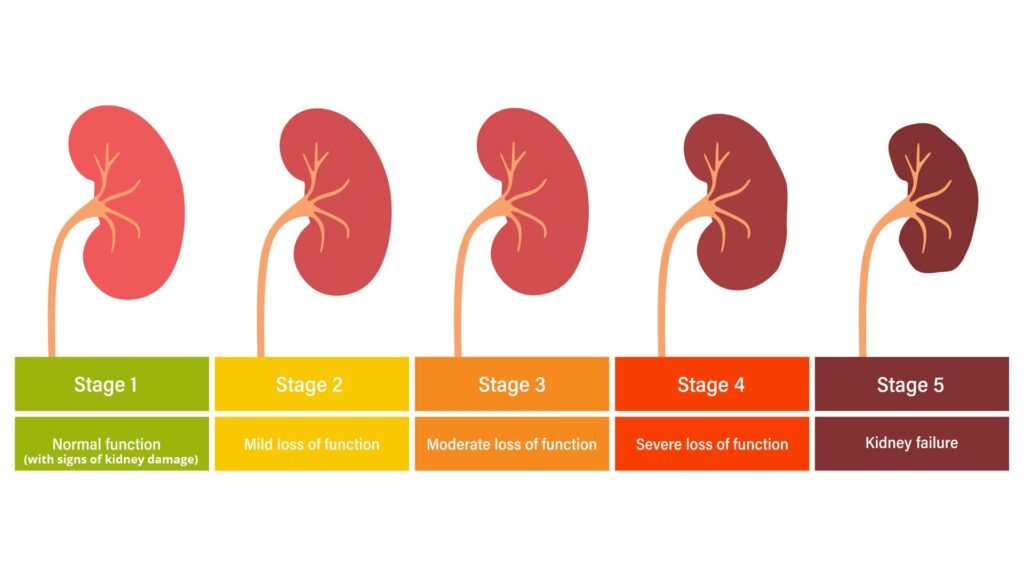Chronic renal failure, aka chronic kidney disease (CKD), can affect dogs or cats but is more common in cats. Over their lifetime, 1 in 3 cats and 1 in 10 dogs could develop CKD. It is typically seen in elderly animals and is usually caused by the wear and tear of aging, although diet and feline vaccines play a role.
Studies show an association between the feline distemper vaccine and CKD. It turns out that the viruses used in the vaccine are grown on feline kidney tissue cultures. While the vaccinated cat’s immune system is being stimulated against the viruses, it is also being stimulated against its own kidneys. That’s a great recipe for CKD.
In my opinion, another contributing factor in CKD is dry pet food. This is especially true for cats. It turns out that cats evolved from desert creatures. Since in the desert, there are few puddles to drink from, cats do not have a strong thirst drive. They were designed to get the fluid they need from the food (mice and birds) they ate.
Enter conventional kibble. If you have ever soaked dry pet food in water and watched it suck up all the fluid, then you have an idea of what happens when pets eat dry food – it sucks much of the fluid out of their systems.
Research has shown that cats eating dry food make a more concentrated urine than those on canned food. The high concentration is due to the dehydration caused by the food. Dehydration damages the kidneys. The more concentrated urine also more easily causes the formation of crystals in the urine. Isn’t it interesting how cats are prone to CKD and urinary crystals? Maybe the food we commonly feed has something to do with it.
To understand CKD we must first explore how normal kidneys function. These organs have lots of duties and play a role in maintaining red blood cell levels, maintaining appropriate blood pressure, and removing toxins and waste products from the body. While kicking waste and toxins out of the body, the kidneys are also tasked with holding on to as much water as they can.
The good news about the kidneys is that under normal circumstances, animals have a lot of reserves in kidney function. Think about it; a person can donate a kidney (which represents ½ of total function) and do just fine. The bad news is that kidneys do not easily regenerate. Once the function is lost, we can’t seem to get it back. You just can’t un-cook a hardboiled egg.
As the kidneys start to fail, they start to leak protein into the urine and lose the ability to hold on to water. This causes the pet to produce more urine – a condition called polyuria or PU. The loss of water causes the pet to have to drink more – a condition called polydipsia or PD. Usually the first signs of CKD are what doctors call PU/PD.
It is important to realize that the loss of water in the urine is causing the animal to drink more and not vice versa. If you think your pet is drinking too much, and take away his water, you may cause dehydration which adversely affects the kidneys. It is imperative that pets with CKD have unlimited access to water.
As CKD progresses, the animal will often lose his appetite and may vomit frequently. This leads to weight loss and weakness. Complicating issues, in the final stages of kidney disease, the pet may become anemic (low red blood cell count). If left to run its course, CKD basically leads to death by starvation.
Until recently, the test result to indicate CKD the earliest was an elevation in the urine protein level. This typically happens when 2/3 of the kidney function is lost. When ¾ of the kidney function is lost, the blood urea nitrogen (BUN) and Creatinine start to elevate.
In the past year, a new test has been made available. It can detect CKD up to 1 ½ years before the BUN and Creatinine tests elevate. The new blood test measures symmetric dimethylarginine (SDMA) which is a bodily waste product that is almost exclusively excreted by the kidneys.
Unfortunately, conventional vets don’t know what to do with this new test. If an otherwise normal pet has an elevated SDMA, we don’t know if it will necessarily lead to CKD. From a holistic point of view, if the kidneys are starting to have problems, there are things we can do.
Once a pet has developed CKD, most vets want to pop them on a low protein prescription diet. Though the names of these diets may sound scientific, what’s inside is not. Remember how protein loss from the kidneys is one of the first signs of CKD? What happens if you lower the protein intake while the body is kicking out more protein? Basically, the body takes protein from its own muscle tissue. While the kidney numbers might look better, the patient is not. Remember that we should always treat the patient, not the numbers.
Studies indicate that protein restriction does not stop the progression of kidney disease in dogs and cats. Protein restriction is only helpful in the late stages of CKD, especially when the blood phosphorus level starts to elevate.
And of course, high-protein diets do not cause CKD. If they did, dogs and cats would not have evolved eating high-protein diets. The ancestors of the dog and cat that could not handle highprotein diets did not live to pass on their genes. If your pet has been diagnosed with kidney failure, there are natural treatments that can help. The first thing to be aware of is that monitoring will help you know what is needed. Many veterinarians will do blood work periodically to see how things are progressing. The BUN and Creatinine are the most commonly monitored tests. However, it is important to also keep an eye on the phosphorus, the hematocrit (red blood cell count), and the potassium.
The BUN and Creatinine monitor the progression of the disease. The phosphorus often elevates as the kidney fail and can cause lack of appetite and vomiting. The hematocrit helps us keep an eye out for anemia. Finally, some cats with kidney disease will develop low potassium which complicates the condition. Be sure your vet is monitoring everything and is not suffering from tunnel vision.
The first thing for any pet with renal disease is to feed the kidneys by providing the nutrients they need to function as well as possible. One great supplement for this is the Fermented Fish Stock made by Answers Raw Pet Foods. They also make an excellent probiotics delivery system in their Fermented Raw Goat’s milk. Most pets find this very yummy and it often gets a finicky pet eating again. Another excellent supplement to feed the kidneys is Canine or Feline Renal Support from Standard Process. If your pet develops a low potassium level, there are other supplements that can be added to the mix.
A supplement that can help the body rid itself of waste that the kidneys are not handling well is called Azodyl. It provides special probiotic bacteria that basically suck the nitrogenous waste of the body out through the colon. This is a good place to start for pets with high BUN/Creatinine. If your pet’s phosphorus is starting to go above normal, a phosphorus binder can be used. Aluminum Hydroxide is the most common one. It binds to phosphorus in the gut and keeps it from getting absorbed. I like Phos-bind by Rx Vitamins.
Milk thistle is well known for its positive effects on the liver but it can help the kidneys too. But, my favorite herb for the kidneys is Rehmannia. It is part of Chinese herbal formulas for kidney failure and helps improve kidney function. It is best to have your pet seen by a TCM practitioner to find the right Rehmannia formula for your pet.
When you look at all the supplements that can help with renal failure, it is easy to see that you can’t get everything into most pets. There just wouldn’t be room for food if you gave them all. I suggest you try the different ones and see what works for you and your pet. I have also found acupuncture to help with a pet’s appetite and renal function. And it is one less thing you need to get down the pet’s throat.



